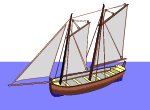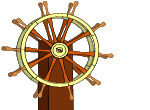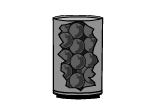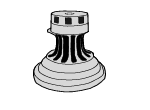
Glossaire anglais-français des termes de la marine ancienne 1780-1830
| A | B | C | D | E | F | G | H | I | J | K | L |
| M | N | O | P | Q | R | S-Sh | Si-Sz | T | U | V | WXYZ |
 |
 |
 |
 |
| T - dictionnaire anglais-français des termes marins, à l’intention des amateurs des romans historiques 1780-1830 | ||
tack: (2) position of the ship in relation to the wind: |
|
amure (nf): (2) position d’un bateau par rapport au vent: |
| to tack to windward (to sail upwind, close-hauled, changing tack so that the ship's course is a zig-zag). See also go about | louvoyer, tirer des bords (v, remonter contre le vent au plus près, en virant souvent de bord, adoptant une trajectoire en zigzag). Voir aussi virer de bord | |
| tack > to change tack | changer d'amures, virer de bord (v) | |
| tackle (mechanism consisting of several groups of pulleys, which sailors call blocks, with a rope running between them; its purpose is to give mechanical advantage so as to reduce the effort needed to bring two blocks together, enabling the user to lift heavy objects, brail up the sails, etc. Landsmen call it a block-and-tackle. See also whip) | palan (nm), moufle (nf). Mécanisme composé de plusieurs poulies et d'un cordage passant par elles pour effectuer des travaux de force; Il sert à réduire l’effort nécessaire (ou démultiplier la force utilisée) pour rapprocher les deux groupes de poulies, afin de soulever des objets lourds, carguer les voiles, etc. Voir aussi cartahu |
|
| tackle > stay tackle | palan d'étai | |
| tackle > mainstay tackle | palan d'étai de grand mât | |
| tackle > train tackles - see cannon | palans de recul, palans de retraite - voir canon | |
| taffrail (the top of a ship's poop) | lisse de couronnement (nm, haut de la poupe) | |
| to take in a sail (to furl a sail) | serrer (v, serrer une voile) | |
| tampion, tompion - see cannon | tape, tampon - voir canon | |
| tar : (1) used as a protective treatment for ropes (2) Jack Tar, nickname for any sailor |
(1) goudron (nm, sert comme enduit pour la préservation des cordages) (2) Jean Goudron (marin, loup de mer) |
|
| tarred | goudronné (adj) | |
| target | cible (nf) | |
| tarpaulin, awning (piece of canvas used as a protective covering) | bâche (nf) prélart (nm); pièce de grosse toile dont on couvre quelque chose pour la protéger | |
| tartan (small merchant vessel with a lateen mainsail and jib. See vessel comparison chart) | tartane (nf, petit bâtiment marchand à voile latine et foc. Voir tableau comparatif des bâtiments) | |
| telescope, glass | lunette, longue vue (nf) | |
| thick (adj, poor visibility due to bad weather) | temps bouché (mauvaise visibilité due au mauvais temps) | |
| thole pin (pin or pair of pins that are set into the gunwale of a boat as a pivot for an oar) | tolet (nm, cheville ou paire de chevilles que l'on plante dans le plat-bord d'un bateau afin de maintenir un aviron) | |
| thwart (oarsman's seat) | banc de nage, banc de rameur (nm) | |
| tide (regular rise and fall in sea level caused by the gravitational pull of the moon and sun. See also current) | marée (nf, mouvement périodique de montée et de descente du niveau de la mer dû à l'attraction de la lune et du soleil. Voir aussi courant) | |
| tide > spring tides | grandes marées, marées de vives eaux | |
| tide > neap tides | marées de mortes-eaux | |
| tide > high tide | marée haute, pleine mer | |
| tide > low tide | marée basse, basse mer, basse eau | |
| tide > flood tide (rising tide; rising sea level; incoming current) | flot (nm, marée montante; le mouvement montant des eaux des mers; courant de flot) | |
| tide > ebb tide (falling tide; sea level going down; outgoing current) | jusant (marée descendante; le mouvement descendant des eaux des mers; courant de jusant) | |
| tide > ebb (falling tide) | reflux (nm, marée descendante) | |
| tide > tide tables | annuaire des marées (nm) | |
| tiller (wooden rod attached to a boat’s rudder and used to steer it - see helm) | barre franche (nf, timon ; tige de bois attachée au gouvernail d’un bateau et qui sert à le mouvoir - voir barre) | |
| tiller lines, tiller rope | drosse de gouvernail (nf) | |
| timbers (the structural parts of a ship) | charpente d’un navire (nf) | |
| tompion, tampion - see cannon | tampon, tape - voir canon | |
| tonnage (burden, burthen; volume or stowage capacity of a ship, especially of her hold; for example a vessel of five hundred tons burthen) | tonnage (nm, jauge, la quantité de tonneaux que contient un navire, sa capacité d'arrimage. Par exemple, un vaisseau de cinq cents tonneaux) | |
| ton: (1) unit of volume of 35 cubic feet. See tonnage and burthen (2) unit of mass of 2000 pounds (short ton) or 2240 pounds (long ton / imperial ton) |
tonneau (nm) : (1) unité de volume de 42 pieds cubes. Voir tonnage et capacité d'arrimage (2) unité de poids de 2000 livres |
|
| top (fighting-top; a platform installed between the head of the lower mast and the foot of the topmast) | hune (nf, plate-forme installée à la tête du bas-mât et au pied du mât supérieur, appelé mât de hune) | |
| top > mizzen top | hune d'artimon | |
| top > main top | grande hune | |
| top > fore-top | hune de misaine | |
| topgallant - see sail > topgallant | perroquet - voir voile > perroquet | |
| topman (specialist seaman who handles the sails, especially up in the rigging) | gabier (nm, matelot spécialisé dans la manœuvre de la voilure, surtout dans la mâture) | |
| top-hamper (windage; the amount of hull and rigging above the water. The more top-hamper a ship has, the more the wind can get a grip on it) | fardage (nm, volume des œuvres mortes et gréement qui se trouvent au-dessus de l'eau. Plus le fardage est important, plus le navire offre une grande prise au vent) | |
| topping lift (uphaul; a rope from high up the mast which is used to support the end of a spar in the absence of its sail) | balancine (nf, cordage partant du haut du mât et servant à soutenir l'extrémité libre d'un espar en l'absence de sa voile) | |
| topsail - see sail > topsail | hunier - voir voile > hunier | |
| topsail schooner - see schooner | goélette à hunier - voir goélette | |
| tow - see oakum | filasse - voir étoupe | |
| to tow | remorquer, touer (v) | |
| trade winds (moderate easterly winds that blow steadily in tropical regions. See also anti-trades and roaring forties) | alizés (nmpl, les vents alizés; vents d'est soufflant dans les régions tropicales, réguliers et de vitesse modérée. Voir aussi contre-alizés et quarantièmes rugissants) | |
| "Trail oars!" - see rowing | « Laissez courir !» - voir nager | |
| to train: (1) to train a new crewman (2) a trained seaman, a seasoned sailor |
amariner (v): (1) habituer un équipier au métier de marin (2) un homme amariné |
|
| transom (the rear end of a hull, more or less flat and sloping) | tableau (nm, partie arrière de la coque, plus ou moins plate et inclinée) | |
| transport (“commercial vessel, of any size, chartered by the state to transport troops, munitions, provisions, etc. For some years the government has had transport vessles of all sizes built in its own dockyards”) | transport (nm, « bâtiment du commerce, de toute grandeur, affrété par l’état pour transporter des troupes, des munitions de guerre, de bouche, etc. Depuis quelques années, le gouvernement a des bâtiments de transport construits dans ses chantiers de port en tonneaux très différents ») | |
traverse board (a wooden board marked with the 32 points of a compass rose, enabling the navigator to see what course has been sailed, on which tack, and for how long) "The traverse board is a disc with a handle; a compass rose is painted on one side. Along each of the lines that indicates a point of the compass there are eight hole into which pegs can be inserted to show the vessel's course during the eight bells or four hours that make up a watch" See also deck log |
renard des pilotes (nm, rose des vents en bois, sur laquelle ont été tracés les 32 secteurs du compas, permettant au navigateur de savoir quel cap avait été tenu, sous quelles amures et pendant combien de temps) |
|
| treenail, trunnel (hardwood peg used to pin together a ship's structure and planking) | gournable (nf, cheville de bois dur servant à assembler la charpente et les bordages du navire) | |
| trestle-trees (wooden beams; the fighting tops are supported by the trestle-trees and the cross-trees, between which lies the lubber's hole) | élongis (nmpl, pièces de bois; les élongis et les barres traversières supportent la hune et délimitent de chaque côté le trou du chat) | |
| trigger | détente (nf) | |
| trim (longitudinal attitude of a ship or boat. The trim depends on the location of the centre of gravity of the ship and its cargo in relation to the hull's centre of buoyancy) | assiette (nf, inclinaison longitudinale d’un navire ou d'un bateau. L’assiette dépend du centre de gravité du navire et sa cargaison par rapport au centre de carène de la coque) | |
| to trim (a sail) to the wind | border au vent (v) | |
| trunnion - see cannon | tourillon - voir canon | |
| tumblehome (hull-shape which is widest halfway up the side or at the waterline; “the difference between the width of the ship at the height of its main wale and at its gunwale; a ship ... of the first rate is about nine feet narrower at its quarterdeck than at the deck nearest the waterline” | rentrée (nf, frégatage; forme de coque plus large au milieu du franc-bord ou à la flottaison ; « la différence entre la largeur d'un bâtiment à la hauteur de sa première préceinte, et son plat-bord ; ...un vaisseau ... du premier rang a environ neuf pieds de moins large sur ses gaillards que sur son premier pont ») | |
| tweendecks, betweendecks (floor or space between two decks of a ship) | entrepont (nm, étage qui sépare deux ponts dans un navire) | |
| U - dictionnaire anglais-français des termes marins, à l’intention des amateurs des romans historiques 1780-1830 | ||
| to unfurl sails, to make sail | déferler les voiles, larguer les voiles (v) | |
| uniform: (1) working uniform (2) (full) dress uniform |
tenue (nf, uniforme) (1) tenue de travail (2) grande tenue |
|
| to unsheath or draw (a sword or other edged weapon) | dégainer (v, tirer une arme blanche de sa gaine, de son fourreau) | |
| upper works (the exposed part of a hull, above the waterline) | œuvres mortes (nfpl, partie émergée de la coque, au-dessus de la ligne de flottaison) | |
| upstream (see also downstream) | amont (adj, voir aussi aval) | |
| V - dictionnaire anglais-français des termes marins, à l’intention des amateurs des romans historiques 1780-1830 | ||
| vane (flag at the masthead, which indicates the direction and strength of the wind - see also dog-vane) | girouette (nf, pavillon à la tête du mât, servant à indiquer la direction et la force du vent - voir aussi penon | |
| to veer: (1) of a rope, to pay out, to allow some to run out (2) of the wind, to change direction clockwise. See also wind > backing |
virer (v) (1) d’une manœuvre, larguer, laisser aller (2) du vent, changer de direction dans le sens horaire. Voir aussi vent > reculant |
|
| vent or priming-hole - see cannon | lumière - voir canon | |
| vessel (craft, ship) | vaisseau (nm, bâtiment, navire) | |
| victualler (contractor, supplier of provisions) | avitailleur, fournisseur (nm, celui qui fournit des vivres et du matériel) | |
| victualling (providing fresh supplies of food and other stores) | avitaillement (nm, fournir des vivres et du matériel) | |